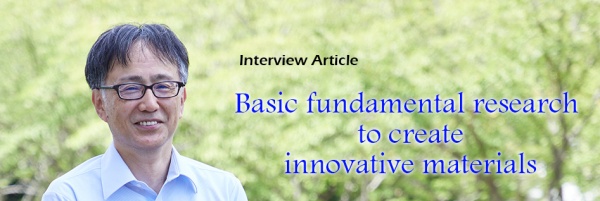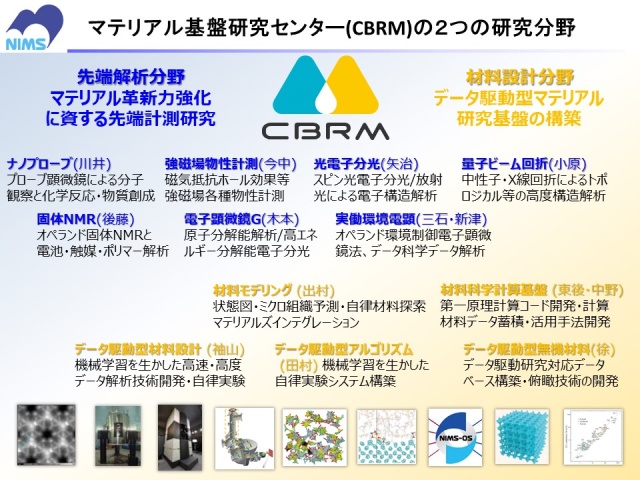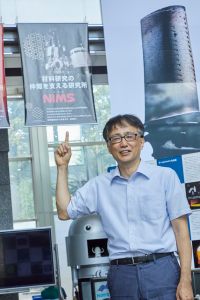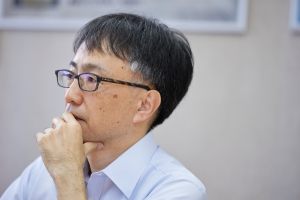ここからサイトの主なメニューです
ここからページの本文です
[Interview Article]
Center for Basic Research on Materials
Koji KIMOTO, Director

- What is the Center for Basic Research on Materials (CBRM)?
Kimoto: CBRM was established at the start of the fifth mid-to-long term plan by bringing together researchers in advanced measurement and data science who had been working separately. The Japanese government has a national policy of "Strengthening materials innovation capability", and NIMS is a materials research institute that plays a central role in this policy. Our center is the only center within NIMS that does not have a materials field on the name of the center, and promotes basic fundamental research for all kinds of materials with the "Advanced Materials Characterization Field", which provides cutting-edge characterization technology for materials, and the "Data-driven Materials Research Field", which focuses on efficient and innovative materials development based on the data science as the two wheels of a vehicle.
Here in the center logo, the blue mountain represents the "Advanced Materials Characterization Field" and the yellow mountain represents the "Data-driven Materials Research Field". New achievements will be generated where two overlap like drops of water. In other words, the synergy effects between the two are expected.

- Why did the two fields become one center at this point in time?
Kimoto: There has been interaction between the two fields for some time. The figure shows the technologies developed and provided by the "Advanced Materials Characterization Field" and "Data-driven Materials Research Field" of the center, and the research in charge. Some of these researchers used to work in advanced characterization, have now moved to the "Data-driven Materials Research Field", where they perform automatic analysis of measured data, for example. One of the reasons is that a large amount of material data becomes possible to obtain where automated and sophisticated scientific instrument has been developed.
As is the case in my own research field, a single photograph (negative film) of atoms was sufficient as a scientific achievement when I wrote my first paper in the late 1980s. Since then, the quality and quantity of the data that can be acquired have improved, and software for controlling the equipment and analyzing the data have been written for effective use of the equipment. As of now, more than 20 shots of 4K images can be recorded per second. While it is wonderful to be able to acquire so much data, machine learning that automatically extracts meaningful insights from the data is necessary.
Furthermore, measurement and data analysis are now more than just a way to acquire data and a way to analyze it. "Data-driven Materials Research", which searches for new materials based on a very extensive materials database including measurement results, is beginning to show a NIMS strength. Under the current situation, I believe that it was quite natural for the two fields to come together.
 |
Message to the students
I really like experiments, and I am still operating some electron microscope from time to time. I have experienced unspeakable joy several times through my research, such as when I was the first in the world to visualize the atomic arrangement of each element using a device that I had modified. I hope that young researchers will enjoy this kind of wonderful experience. NIMS is the best place to do research. Photo: A beautiful electron microscope image taken by Kimoto, Director of CBRM was made in a NIMS poster. |
- What strategies do you have in mind to maximize the Center's strength?
Kimoto: I think it is important for researchers to naturally "get to know" each other, transcending the boundaries of fields and specialties.
I am originally an electron microscopy researcher, but there are many different characterization techniques in electron microscopy. Therefore, I can only say that I am a world-class researcher in a few of them. It is difficult to conduct world-class research unless specialists in each field collaborate with each other. I do not believe that I alone can manage this center, as the situation is similar in all cutting-edge fields.
From my own experience, there have been several times when I have heard about the problems of people in other fields and thought, "If only they had asked me for advice, I could solve their problems right away". Therefore, I believe it is important to get to know each other and develop a relationship where we can talk about our research problems with each other. I think publishing this interview article is also a great opportunity to get to know people inside and outside CBRM, and that is exactly why I am asking you to do so.
When I was appointed Director of the Center in my previous position, I was told by a NIMS Executive at that time, "Please manage the Center as if it were your own laboratory". I think he meant that he wanted me to think of the members as my own team. My role is to promote the achievements of the outstanding members of CBRM to the outside world, and I am willing to do my best efforts.
 |
Message to the company researchers
Our research is fundamental to promote innovative materials development. We believe that the results of this research should be applied to various materials development in Japan. Basic fundamental research sometimes yields unexpected results, which lead to innovation. We hope to work together to boost Japan's materials development from all aspects, from the basic level at academic conferences to joint research. |
- The Center will be a reassuring presence for materials researchers who aim to strengthen the materials innovation, won't it?
Kimoto: I hope so. This center is full of talent. Everyone is particular about the details of their field of expertise, and you could say that we are all "geeks" who aim to be the best in the world. Of course, we are always on a mission for national policy, but each of us likes our own research and takes pride in it.
In order to truly contribute to materials development, both measurement technology and data science must be tailored to each issue. In the case of cutting-edge materials research, where observations cannot be made with ordinary characterization techniques or there is no appropriate calculation algorithm, it is not enough to just buy equipment and technology from somewhere and install it. We develop them in consultation with materials researchers. It is sometimes difficult, but it is a great challenge for us, and can be the most advanced research and development in our field.
Please consult with us if there are any problems with the measurement and characterization, and data science, since we will work together to promote research and development so that we can become a center where it is said, "If it can't be done at CBRM, it can't be done anywhere in the world".
Automation is advancing in various fields of materials research. However, in cutting-edge research, there are still many research coordination and decisions that only humans can make, such as what to measured and by what method, how to analyze the obtained data, and which code to use for simulation. We want our center to play a part in such processes in materials research. For this purpose, we would like to create a "casual atmosphere" where materials researchers can approach us wherever they meet us, and spread a "no fear of failure" spirit where we can "take a change and give it a try", not only within NIMS but also throughout the world of materials research from this center.
Interview & Writing (in Japanese): Akiko IKEDAm Sci-tech communications
PHotographjy: Takahiro MORI
ここからサイトの主なメニューです

